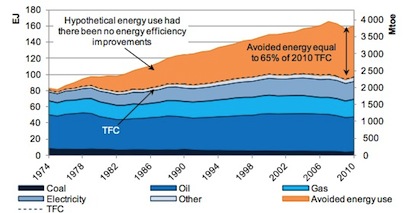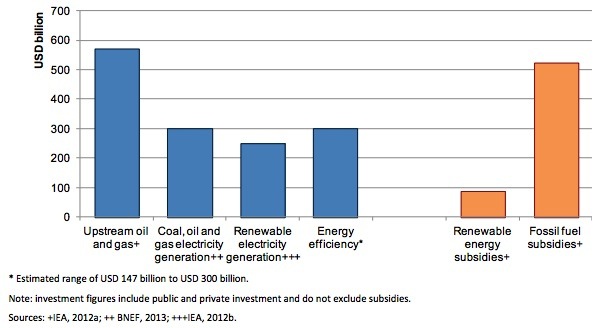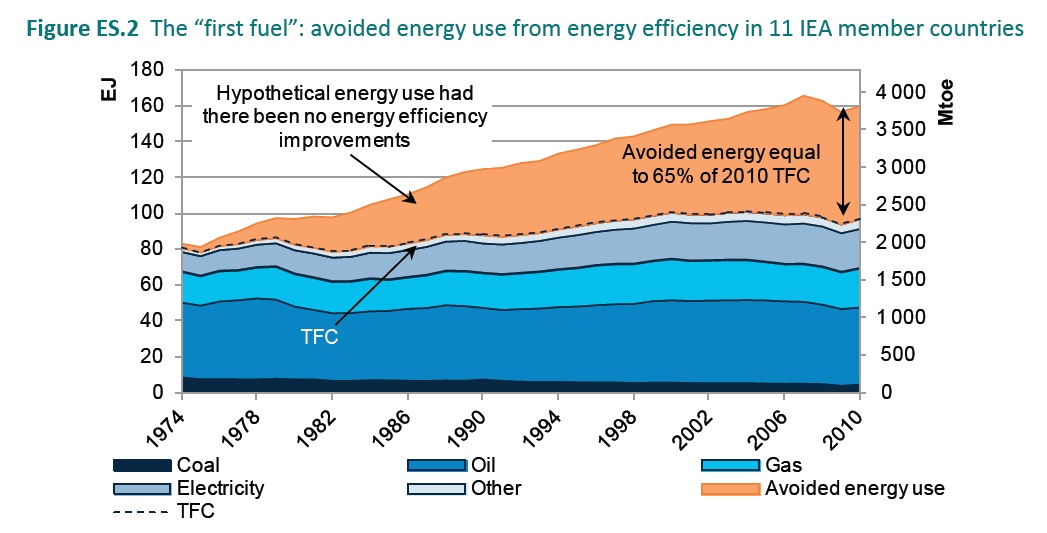Avoided energy use attributable to energy-efficiency investments undertaken since 1974 has resulted in a contribution outstripping the annual consumption of oil, natural gas, electricity, and coal, according to a report by the International Energy Agency, a global NGO.
An analysis of energy consumption in 11 IEA member countries indicates that avoided annual energy use in 2010 was 63 exajoules, or the equivalent of 1.52 billion tonnes of oil. This avoided energy use was larger than the countries' consumption of oil (43 EJ), electricity and natural gas (22 EJ each), and coal (less than 10 EJ).
The equivalent cost of oil for 63 exajoules of energy would have been about $420 billionUS. (Countries included in the analysis were Australia, Denmark, Finland, France, Germany, Italy, Japan, the Netherlands, Sweden, the United Kingdom, and the United States.)
Investments in energy efficiency measures have also reduced the amount of energy needed to produce each unit of gross domestic product, according to the report. As of 2011, total investment in energy efficiency resembled the supply-side investment in renewable or fossil-fuel electricity generation.
However, fossil-fuel development benefits from a much higher level of government subsidies than energy-efficiency measures. In 2011, fossil fuels were the recipient of more than $500 billion in global subsidies, compared with less than $100 billion in subsidies for renewable energy (below).
Table: Global investments and subsidy in selected areas of the energy system, 2011. Source: IEA.
The IEA indicates that governmental policy interventions are the most significant stimulant for energy-efficiency investments. High energy prices are also triggering expansion of the energy-efficiency market, though subsidies for fossil fuels continue to artifically reduce the price consumers pay for energy.
Performance improvements in buildings are targeted as an important factor in continued reduction of global energy use. The report discusses notable investments in this area by Germany, New Zealand, France, and Mexico, mainly involving residential construction.
For the medium term, the IEA predicts that private investment enabled by favorable government policies, rather than direct public investment, will continue to represent the greatest source of funding for energy-efficiency projects.
Influential changes in codes and standards in Canada, France, Germany, South Korea, China, Japan, and the U.K. should drive growth in the energy-efficiency sector. For the U.S., new standards for appliances and continued growth in the ESCO industry may be significant.
Continued savings should be possible during the next decade, according to the agency, perhaps amounting to about 7% of 2010's total global consumption--or greater than the combined current energy use of Australia, Japan, Korea, and New Zealand.
Click here for the full report.
The editors thank Grumman / Butkus Associates for bringing this report to our attention.
Related Stories
Apartments | Jun 27, 2023
Dallas high-rise multifamily tower is first in state to receive WELL Gold certification
HALL Arts Residences, 28-story luxury residential high-rise in the Dallas Arts District, recently became the first high-rise multifamily tower in Texas to receive WELL Gold Certification, a designation issued by the International WELL Building Institute. The HKS-designed condominium tower was designed with numerous wellness details.
Green | Jun 26, 2023
Federal government will spend $30 million on novel green building technologies
The U.S. General Services Administration (GSA), and the U.S. Department of Energy (DOE) will invest $30 million from the Inflation Reduction Act to increase the sustainability of federal buildings by testing novel technologies. The vehicle for that effort, the Green Proving Ground (GPG) program, will invest in American-made technologies to help increase federal electric vehicle supply equipment, protect air quality, reduce climate pollution, and enhance building performance.
Industrial Facilities | Jun 20, 2023
A new study presses for measuring embodied carbon in industrial buildings
The embodied carbon (EC) intensity in core and shell industrial buildings in the U.S. averages 23.0 kilograms per sf, according to a recent analysis of 26 whole building life-cycle assessments. That means a 300,000-sf warehouse would emit 6,890 megatons of carbon over its lifespan, or the equivalent of the carbon emitted by 1,530 gas-powered cars driven for one year. Those sobering estimates come from a new benchmark study, “Embodied Carbon U.S. Industrial Real Estate.”
Mechanical Systems | Jun 16, 2023
Cogeneration: An efficient, reliable, sustainable alternative to traditional power generation
Cogeneration is more efficient than traditional power generation, reduces carbon emissions, has high returns on the initial investment, improves reliability, and offers a platform for additional renewable resources and energy storage for a facility. But what is cogeneration? And is it suitable for all facilities?
Multifamily Housing | Jun 15, 2023
Alliance of Pittsburgh building owners slashes carbon emissions by 45%
The Pittsburgh 2030 District, an alliance of property owners in the Pittsburgh area, says that it has reduced carbon emissions by 44.8% below baseline. Begun in 2012 under the guidance of the Green Building Alliance (GBA), the Pittsburgh 2030 District encompasses more than 86 million sf of space within 556 buildings.
Resiliency | Jun 14, 2023
HUD offers $4.8 billion in funding for green and resilient building retrofit projects
The Department of Housing and Urban Development (HUD) recently released guidelines for its Green and Resilient Retrofit Program (GRRP) that has $4.8 billion for funding green projects.
Codes and Standards | Jun 6, 2023
California’s new power grid modernization plan furthers ambitious climate goals
California’s new $7.3 billion grid modernization plan is a crucial step in furthering its ambitious climate goals. The board of governors for the California Independent System Operator (CAISO), the state’s grid operator, recently approved a strategy to build thousands of miles of new high-voltage transmission lines.
Multifamily Housing | Jun 6, 2023
Minnesota expected to adopt building code that would cut energy use by 80%
Minnesota Gov. Tim Walz is expected to soon sign a bill that would change the state’s commercial building code so that new structures would use 80% less energy when compared to a 2004 baseline standard. The legislation aims for full implementation of the new code by 2036.
K-12 Schools | May 25, 2023
From net zero to net positive in K-12 schools
Perkins Eastman’s pursuit of healthy, net positive schools goes beyond environmental health; it targets all who work, teach, and learn inside them.
Mass Timber | May 23, 2023
Luxury farm resort uses CLT framing and geothermal system to boost sustainability
Construction was recently completed on a 325-acre luxury farm resort in Franklin, Tenn., that is dedicated to agricultural innovation and sustainable, productive land use. With sustainability a key goal, The Inn and Spa at Southall was built with cross-laminated and heavy timber, and a geothermal variant refrigerant flow (VRF) heating and cooling system.



















